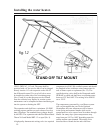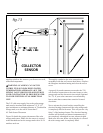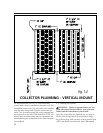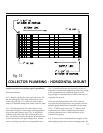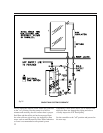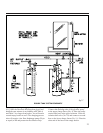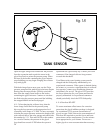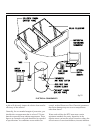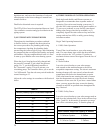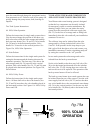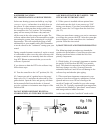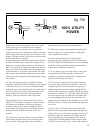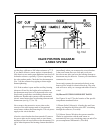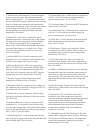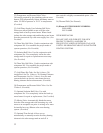
26
depletion rate, and cause the formation of scale and
other deposits on the heat exchanger's internal heat
transfer surfaces.
Distilled or deionized water is required.
The HTF pH level must be maintained between 8 and
10 to minimize corrosion and glycol oxidation in the
piping system.
5) SYSTEM START-UP PROCEDURES
Throughout the installation procedures outlined
in Section 4 above, emphasis has been placed on
the correct procedures for plumbing and wiring
the components, checking for plumbing leaks,
pressurizing the collector glycol loop, and eliminating
any trapped air that can impact uid quality and pump
performance. Having completed these tasks it is time
to start up your Rheem solar water heating system.
When the glycol loop has been fully charged and
the pressure is around 25 psi (check the pressure
gauge, No. 7), set the differential controller to
the "Automatic" setting. This will activate your
circulating pump. The controller allows you to set the
"on" differential. Turn the red rotary switch inside the
control housing to 12.
Adjust the valve settings in accordance with Section 6
below.
6) THREE MODES OF SYSTEM OPERATION
Both single and double tank Rheem systems are
designed to accommodate three separate modes of
operation. Your solar water heating system can, (1)
provide 100% solar operation during good weather, or
(2) serve as a preheater to your electric water heater
adding solar energy when and as available, or (3)
completely bypass the solar collector loop and solar
storage tank and run 100% on utility power during
inclement weather.
Single Tank Operating Instructions:
6.1 100% Solar Operation:
Turn off the circuit breaker to your solar storage
tank. If a water heater time switch has been installed,
set the switch to the "off" position. If you have a
mechanical timer remove the trippers from the face of
the switch.
6.2 Solar Preheat
Leave the circuit breaker to your solar storage
tank on and set the tank thermostat to the lowest
acceptable temperature setting. The electric resistance
heating elements will come on only when the tank
temperature falls below the thermostatic set point.
If the solar heated water entering the tank is warmer
than the thermostatic set point, the electric heating
elements will not come on. If you have a water heater
timer, you may preset the timer to turn the heating
element on and off at specied times throughout the
day if desired.
6.3 100% Utility Power
Leave the circuit breaker to your solar storage tank on
and close the isolation ball valves in the collector loop
(Nos. 5 and 10). In this mode of operation you must
turn off the circulation pump. To turn the pump off
P.13
collector glycol loop. An inexpensive flow meter
such as manufactured by Blue White Industries or
Letro is recommended as an optional system
component. A flow meter allows you to monitor
and adjust the flow rate through the piping and
also to visually inspect the HTF fluid quality.
Set the controller to the "off" position and pro-
ceed to the next step.
4.12.4 Mix the Dowfrost HD propylene glycol
and distilled water mixture in accordance with
Table 4 and Table 5 in a large clean bucket. You
will need a second empty bucket as well. The
charging process also will require a low flow
diaphragm pump (Flojet or equal) to fill and pres-
surize the collector loop.
Connect the discharge side of the pressure pump
to the upper charge faucet (No. 9) Place the
pump suction side hose in the glycol solution.
Close the isolation ball valve (No. 10) and con-
nect a second hose to the lower charge faucet
(No. 11). Place the other end of the hose in the
empty bucket.
Open the upper charge faucet and allow the
pressure from the expansion tank to push the
water in the glycol loop back to prime the pres-
sure pump. When the hose in the bucket con-
taining the glycol mixture stops bubbling you
may begin charging the collector loop with glycol.
With both charge faucets now open, run the
Flojet pressure pump until the pinkish glycol mix-
ture begins flowing into the empty bucket.
Quickly switch the hose from the empty/return
bucket to the bucket containing the glycol mix-
ture. Continue to circulate the fluid using the
pressure pump until the bubbling has stopped
and the air has been purged.
4.12.5 After charging the collector loop, shut
the lower charge faucet and let the pressure
pump drive up the loop pressure to the appropri-
ate level (Generally in the range of 25 PSI). To
more accurately calculate the proper pressure
measure the height of the solar collector above
the solar storage tank and divide this number by
2.31. Then add 20 PSI to this number. As a word
of caution, the pressure in the glycol loop should
not exceed 45 PSI when the system is operational
on a good sunny day. Contact your solar con-
tractor if the charged collector loop pressure
exceeds this threshold.
Your SolaRay solar water heating system must be
charged and the fluid quality maintained by an
experienced contractor. If the system is drained
during the winter, or you notice a significant drop
in collector loop pressure, contact your installa-
tion contractor immediately for service. The gly-
col HTF provides the freeze protection for your
system and must be properly maintained. An
experienced contractor should periodically check
the HTF fluid quality.
4.12.6 Dowfrost HD HTF
To ensure maximum effectiveness for corro-
sion protection, the glycol inhibitor package
is designed for a minimum 25-30 percent
concentration of glycol in water. Table 4
shows the concentrations of Dowfrost HD
required to provide freeze and burst protection at
various temperatures. Use the mixture most
appropriate for your climate. Do not use a high-
er glycol to water concentration than necessary,
as this will adversely impact the relative heat
transfer efficiency of the solution.
Table 4
Percent (volume) Glycol Concentration Required
Temperature F For Freeze Protection For Burst Protection
20 18% 12%
10 29 20
0 36 24
-10 42 28
-20 46 30
-30 50 33
-40 54 35
-50 57 35
-60 60 35
Table 5
Total Collector Loop Fluid Capacity In Gallons*
1 Collector System 4 Gallon
2 Collector System 5 Gallons
* Assumes a total 100’ pipe run using 3/4" Type
M hard copper tubing. The Rheem/Ruud heat
exchanger has a 2.2 gallon fluid capacity.
P.13
collector glycol loop. An inexpensive flow meter
such as manufactured by Blue White Industries or
Letro is recommended as an optional system
component. A flow meter allows you to monitor
and adjust the flow rate through the piping and
also to visually inspect the HTF fluid quality.
Set the controller to the "off" position and pro-
ceed to the next step.
4.12.4 Mix the Dowfrost HD propylene glycol
and distilled water mixture in accordance with
Table 4 and Table 5 in a large clean bucket. You
will need a second empty bucket as well. The
charging process also will require a low flow
diaphragm pump (Flojet or equal) to fill and pres-
surize the collector loop.
Connect the discharge side of the pressure pump
to the upper charge faucet (No. 9) Place the
pump suction side hose in the glycol solution.
Close the isolation ball valve (No. 10) and con-
nect a second hose to the lower charge faucet
(No. 11). Place the other end of the hose in the
empty bucket.
Open the upper charge faucet and allow the
pressure from the expansion tank to push the
water in the glycol loop back to prime the pres-
sure pump. When the hose in the bucket con-
taining the glycol mixture stops bubbling you
may begin charging the collector loop with glycol.
With both charge faucets now open, run the
Flojet pressure pump until the pinkish glycol mix-
ture begins flowing into the empty bucket.
Quickly switch the hose from the empty/return
bucket to the bucket containing the glycol mix-
ture. Continue to circulate the fluid using the
pressure pump until the bubbling has stopped
and the air has been purged.
4.12.5 After charging the collector loop, shut
the lower charge faucet and let the pressure
pump drive up the loop pressure to the appropri-
ate level (Generally in the range of 25 PSI). To
more accurately calculate the proper pressure
measure the height of the solar collector above
the solar storage tank and divide this number by
2.31. Then add 20 PSI to this number. As a word
of caution, the pressure in the glycol loop should
not exceed 45 PSI when the system is operational
on a good sunny day. Contact your solar con-
tractor if the charged collector loop pressure
exceeds this threshold.
Your SolaRay solar water heating system must be
charged and the fluid quality maintained by an
experienced contractor. If the system is drained
during the winter, or you notice a significant drop
in collector loop pressure, contact your installa-
tion contractor immediately for service. The gly-
col HTF provides the freeze protection for your
system and must be properly maintained. An
experienced contractor should periodically check
the HTF fluid quality.
4.12.6 Dowfrost HD HTF
To ensure maximum effectiveness for corro-
sion protection, the glycol inhibitor package
is designed for a minimum 25-30 percent
concentration of glycol in water. Table 4
shows the concentrations of Dowfrost HD
required to provide freeze and burst protection at
various temperatures. Use the mixture most
appropriate for your climate. Do not use a high-
er glycol to water concentration than necessary,
as this will adversely impact the relative heat
transfer efficiency of the solution.
Table 4
Percent (volume) Glycol Concentration Required
Temperature F For Freeze Protection For Burst Protection
20 18% 12%
10 29 20
0 36 24
-10 42 28
-20 46 30
-30 50 33
-40 54 35
-50 57 35
-60 60 35
Table 5
Total Collector Loop Fluid Capacity In Gallons*
1 Collector System 4 Gallon
2 Collector System 5 Gallons
* Assumes a total 100’ pipe run using 3/4" Type
M hard copper tubing. The Rheem/Ruud heat
exchanger has a 2.2 gallon fluid capacity.



